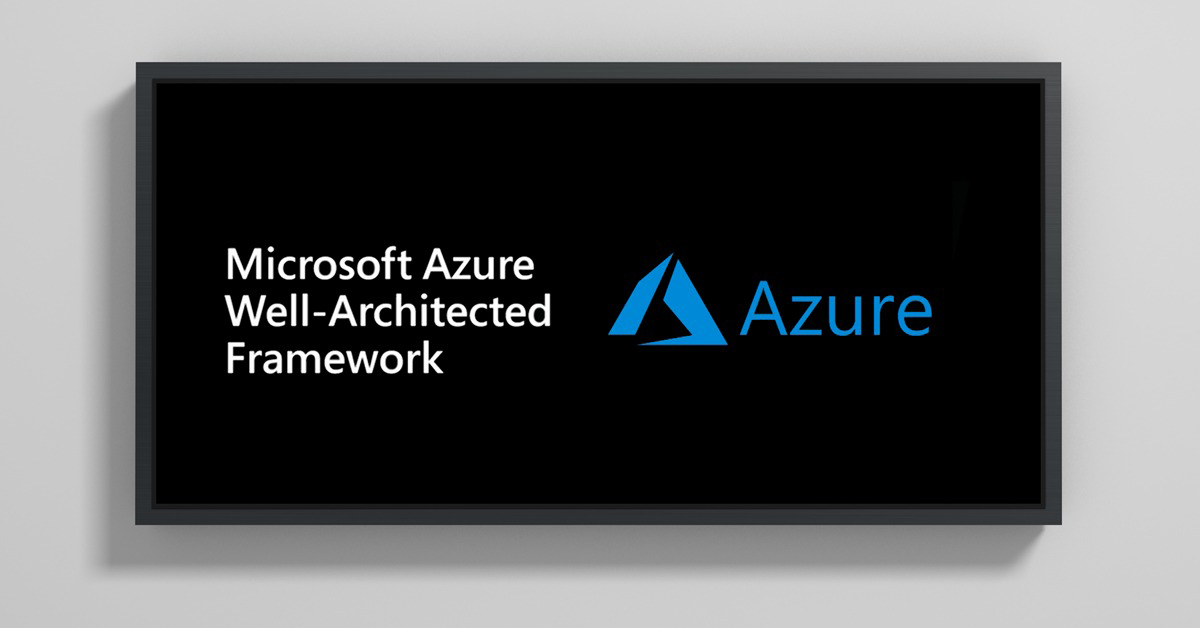Microsoft azure well-architected framework

Data Analyst
Experienced data analyst working with data visualization, cloud computing and ETL solutions.
August 13, 2020
Microsoft has launched its Azure Well-Architected Framework that aids users to build and develop adequate solutions that enhance the quality of cloud workloads. The Well-Architected Framework offers technical efficiency for workloads with five pillars of development. This enables the users and customers to devise well-constructed and high-quality workloads on Azure.
What is the Azure Well-Architected Framework?
The Azure or Microsoft Azure is created by Microsoft for cloud computing. It facilitates developing, testing, and managing applications and services through data centers managed by Microsoft. It supports various programming tools, languages, and frameworks that include third-part and Microsoft specific software and systems.
Azure Well-Architected Framework developed by Microsoft is a group of guiding principles that enable users to progress with the quality of their workload. They are easy to follow and efficient and helps you to highlight the right area to optimize workloads. The technical guidance provided by a Well-Architected Framework focus on the success of the customer. The framework functions on the five pillars of architecture excellence; they are, cost efficiency, operational excellence, performance optimization, security, and reliability.
Five pillars of Microsoft Azure Well-Architect Framework
The Microsoft Azure Well-Architected Framework facilitates improved quality for workloads mainly across the five pillars. They are the five pillars of architectural excellence that helps customers to achieve success with well-architected workloads on Azure. Let us look closer to the five pillars of the Microsoft Azure well-architect framework.

Cost optimization
Cost efficiency and optimization is the primary area to be highlighted while developing and designing a cloud solution. The cost optimization guideline of Well-Architected Framework urges to apply the build-measure-learn principle to accelerate the market value. According to this framework from Microsoft, one should utilize and follow a pay-as-you-go policy for developing architecture and invest with small sections than large investments. It suggests using the cost calculators for estimating the total cost, initial cost, and operational cost. The framework helps to control the cost limits and budget of your solution efficiently. The cost optimization guideline helps the customers to develop a cost-efficient model, review the principles for cost management, to create budget plans and strategies, and to analyze the cost enhancing agendas.
Operational excellence
This pillar of Microsoft Azure's Well-Architected Framework helps for the operational success of the solution running in production. The arrangements of a solution in the framework must be reliable and conventional. For yielding the optimum output it must be completely automated, hence could eliminate the human error. The procedure must be quick and seamless and must be conducted in routine. It also must be viable for quick rollbacks as well as roll forward to sync with the updates and problem fixing procedures. This feature eliminates bugs and errors.
The monitoring procedures of the solution are important for a framework. The cloud applications function in data-centers where the complete access to infrastructure and operating system are limited. This pillar of Microsoft azure Well-Architected Framework enables efficient monitoring and diagnostics that highlight the system and thus enables to analyze the flaws and errors easily. The operational systems must be visible and must use consistent logging schemes that help to interconnect events across the framework.
The important procedures for monitoring and diagnostics include instrumentation that generates the raw data, web server credentials, diagnostics developed into Azure and other platforms, etc. The collection and storage tool of monitoring and diagnostics functions to consolidate every data to one space. The analysis and diagnosis section helps to troubleshoot problems and bugs and to analyze the complete condition of the solution. Visualization and alerts use the telemetry data to highlight the trends and alert the operations.
The operational excellence pillar of the Microsoft Azure Well-Architected Framework helps to develop and design patterns for managing and monitoring workloads. The monitoring and diagnostics procedures are implemented for obtaining great operational excellence.
Performance efficiency
According to Microsoft, the performance efficiency of a solution in a framework indicates the potentiality of the workload to meet the requirements of the users efficiently. This pillar of Azure Well-Architected Framework provides guidelines to achieve these goals efficiently and accurately. This is mainly achieved by scaling the solutions accurately.
The scaling procedures of an application include vertical scaling and horizontal scaling. The vertical scaling or scaling up indicates the process of escalating the potential of a resource. The horizontal scaling or scaling out is the process of accumulating new instances of the resource. There are significant advantages for horizontal scaling over vertical scaling. With horizontal scaling, applications could be devised to function on numerous nodes. It is elastic, as in it can include more instances if the workload increases and at the same time could eliminate them during stilled periods. The horizontal scaling is cheaper than the vertical scaling. It also helps to enhance the resiliency via redundancy. The application functions even if an instance goes down. The vertical scaling enables its functions without altering the application.
Performance and load testing must be conducted to detect potential bottlenecks. The parts of systems such as database cause the bottlenecks and must be carefully designed to scale out. The performance efficiency pillar of the Microsoft Azure Well-Architected Framework helps to analyze the application from a scalability standpoint. It helps to devise and design patterns for enhancing scalability and performance. It facilitates auto-scaling procedures, caching, CDN, data partitioning, and much more.
Reliability
The reliability of the workload is identified with its resilient and availability features. The resiliency feature of a workload is the capacity of the system to survive the failures and function after the fall. Resiliency aims to bring back the application to work efficiently after an occurrence of failure. The availability feature of the workload enables the users to access the workload when they wish to.
Cloud computing applications must be developed to face occasional failures and overcome those. The Azure platform has resiliency features that are built into the platforms and framework. Resiliency policies could be applied to different levels of architecture. Some policies for enhancement must be applied for enabling this feature. Tactical improvements will allow a significant difference. With accurate monitoring and diagnostics will help to recognize the failures when they occur and to analyze the root cause.
The reliability pillar of the Microsoft Azure Well-Architected Framework helps to design reliable Azure applications for the workload. It also helps to devise patterns that facilitate resiliency. It provides practices such as transient fault handling and guidance for specific services.
Security
Security is the most important part of a workload application. The designing of managing every part of an application requires the assurance of security. The framework platform offers security shield against numerous threats and intrusions. It is necessary to develop security for your application to enhance the quality of the workload.
The security is necessary for identity management in the Azure platform. It authenticates and authorizes the users to access management service. The active directory of Azure integrates with numerous applications. The control access for enabling protection of your infrastructure must be installed. It helps to grant access only to authentic users. The security for the application must be followed to prevent attacks and to enable protection. The data of your application should be encrypted and protected to store and save the authenticity of the data.
The security guideline of the Microsoft Azure Well-Architected Framework provides incorporated monitoring and strategy management. This pillar supports the documentation of azure security. It is facilitated by the Microsoft trust center.
These pillars facilitate:
• Management of cost and maximizing the value offered by the applications. The features of the Microsoft Azure Well-Architected Framework help to achieve effective architecture and to achieve greater business goals. This helps to manage the cost within the designated budget.
• Efficient operation processes that help the proper functioning of a system. The pillars of Microsoft Azure Well-Architected Framework facilitate the effective functioning of applications with proper implementation and management.
• It enables the system to accommodate changes. It prioritizes the scalability to develop and implement an application. It helps to manage the maintenance cost within the budget and enhance the user experience.
• The features of the Microsoft Azure Well-Architected Framework helps to overcome failures and function with ease beyond the failures. The cloud computing environment helps to scale the applications and minimizes the efforts and enhances the efficiency to survive even after failure.
• Provides security shield and protection of data in applications from threats and attacks. The security is the foundation aspect of any architecture. The confidentiality, integrity, and reliance of the application against the threats and attacks of data and systems are ensured by the security pillar of the Microsoft Azure well-architect framework.
To conclude
The technical requirements of the business alter and progress with time. It is necessary to implement applications that can increase the efficient functioning of the system. The Microsoft Azure Well-Architected Framework enables the architectural evolution, and to educate and enable the systems to develop and configure the application systems. It automates and reduces the operational costs, reduces the errors, and ensures the consistency of application. With five pillars of execution, Microsoft Azure Well-Architected Framework helps you to manage the complexity and enhance the efficiency of your business systems. Design, develop and execute efficient and seamless software applications with Microsoft Azure Well-Architected Framework.













